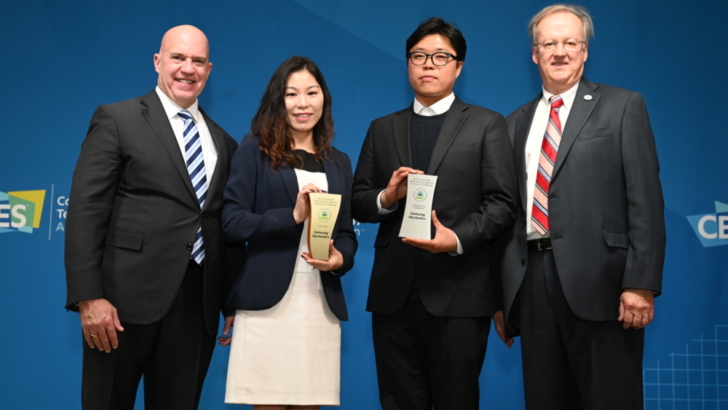[Interview] The Story of Eco-Packaging – How Upcycling is Transforming TV Packaging
on May 7, 2020

Last April, Samsung Electronics introduced its new ‘eco-packaging’ – a new kind of product packaging that facilitates the upcycling of the boxes that come with the company’s global lifestyle TV models, which include ‘The Frame,’ ‘The Serif’ and ‘The Sero’. The special cardboard boxes are designed to allow consumers to upcycle the packaging their televisions come in into small, versatile pieces of furniture. The thick, corrugated cardboard that the packaging is comprised of can be used to construct small tables and shelves, and building instructions can be accessed by scanning QR codes on the outsides of the boxes.
Samsung Newsroom interviewed the designers from Samsung Electronics’ Visual Display Business who, in developing the new eco-packaging, sought to “not only work to develop an outstanding product, but also to realize the promise of environmental sustainability.”
Eco-Packaging – Inspired by the Way People Use Their TVs

Eco-packaging designers, Daehee Yoon from the Product Design Group (left) and Jonathan Whang from the Future Experience Design Group
“Mustn’t there be a way to turn TV packaging into something useful, rather than just disposing of it?” The development of the eco-packaging initiative began with this simple question. “Nowadays, more and more consumers are interested in protecting the environment,” explained designer Daehee Yoon, “With eco-packaging, they could realize environmental protection simply by purchasing goods like they usually would. That was the idea that drove us.”
However, the core idea of reusing packaging material was not enough by itself – concrete measures were required to truly realize the designers’ vision. While the designers were planning the project, the ways in which consumers were using The Serif gave them an idea. Many consumers who were buying the new TV were also purchasing additional drawers or cabinets in which to store their television accessories. “With this in mind, we began to study corrugated cardboard products in the market and visit producers of small furniture,” explained designer Jonathan Whang.
‘Dot Pattern’ Matrix Design – Making DIY Easy
While making a product aesthetically pleasing is important, designers can never lose sight of usability. Therefore, for the eco-packaging designers, the goal was to develop a product that not only met the brief, but was also both easy to use and durable. At first, the designers thought of cutting guiding lines into the cardboard and providing printed plans. However, they soon realized that such methods could limit the number of building methods made available and lead to goods sustaining damage during delivery.

Eventually, the designers came up with the ‘dot pattern’ design. By printing a dot matrix directly onto the cardboard, users would receive easy-to-follow guidance for upcycling, and the product would be protected, all with barely any additional costs or carbon emissions incurred. “One out of every five dots is larger than the others, and the number of dots serves as the unit of measurement,” explained Yoon, “This makes building your own upcycled furniture easy and accessible, and additionally makes the furniture look good once it’s built.”

Sungdo Son, one of the designers from Future Experience Design Group
In addition to facilitating upcycling, the eco-packaging initiative provides paperless electronic manuals with a wide range of building plans that can be accessed by scanning QR codes printed on the tops of the boxes. “The QR codes enable you to access building manuals swiftly without the need to install an app,” Sungdo Son related, “The electronic format also makes it easier to add and modify plans.”
Innovative Sustainability
Printing dots on boxes and providing digital building plans might sound quite straightforward. However, the designers faced a significant challenge when it came to developing plans that were easy to follow and a final product that was both durable and attractive. “We had to change our strategy several times over before we eventually came up with a final solution that ticked all the boxes,” explained Whang.
Elaborating on what the building experience is like for consumers, Whang related that, “The level of building expertise required and the time it takes to build each respective piece of furniture are noted in the manuals so that consumers can make informed choices about what to make with their packaging. After the eco-packaging was distributed, it was interesting to see how much the final products varied in terms of shape and appearance, despite the fact that they were built using the same sets of plans.”

(From left) Designers Jonathan Whang, Sungdo Son and Daehee Yoon holding pieces of furniture constructed with eco-packaging
Commenting on the eco-packaging initiative, the designers said, “Although our eco-packaging may not bring about a drastic reduction in paper waste, we hope that our efforts will seek to increase awareness for the relevant environmental issues.” It was this wider conscientiousness that contributed to the team winning a ‘CES Innovation Award’ in 2020.
What’s more, the story of the eco-packaging initiative has not drawn to a close yet. “We are cooperating with Dezeen, a lifestyle design magazine based in the U.K., to hold an eco-packaging design competition, which will be open to all,” reports Son. “The participants will be asked to create designs for different types of eco-packaging using environmentally friendly materials and corrugated cardboard.”

